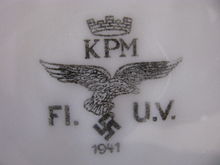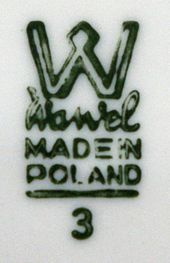Krister Porcelain Manufactory

The Krister Porcelain Manufactory (KPM) was one of the oldest porcelain manufacturers in Lower Silesia . The factory was founded in Waldenburg (today Wałbrzych ) in 1831 by the porcelain painter Carl Krister (1802–1869). At the turn of the 19th and 20th centuries, it was one of the largest porcelain-producing companies in the German Empire. The company went out in 1971.
history
19th century
In 1829 the blue painter and porcelain worker Carl Krister joined the Hayn porcelain factory in Waldenburg. The founder of this factory was the linen dealer Johann Traugott Hayn. In 1831 Krister leases the factory. Carl Krister's independent entrepreneurial activity begins. That is why this year is considered to be the founding date of the Kristersche Porcelain Manufactory. In 1835 Krister bought his leased porcelain factory and the Rausch porcelain factory, also in Waldenburg. He puts these together. In the early years, the products were strongly based on the products of the Königliche Porzellan-Manufaktur Berlin . This did not only apply to shapes and decors, but also to the flooring brand. Its economic success was not based solely on imitation. Krister served the needs of the growing urban population for porcelain products that were on the one hand inexpensive, but on the other hand were equivalent in appearance to the valuable porcelains of the upper classes. He pioneered the mass production of porcelain. He also tried to be largely independent of suppliers.
In 1856, the 25th year of its existence, the company had around 1200 employees, a ramming and rubbing plant for porcelain masses, a kaolin pit in the Seilitz mining area near Meißen, including a slurry mill. Furthermore, Krister owned clay, feldspar and quartz deposits as well as stakes in coal mines, since his kilns had been fired with hard coal since 1845. A brick factory provided the firebricks required for the kilns. And the boards for the transport boxes were sawn in the company's own board cutting plant.
In 1857 and 1867, Krister products were awarded medals at the Paris World's Fair. The company's founder died on November 10, 1869. The "Krister Porcelain Manufactory" continued as a family business. The number of employees reached a peak in 1871 at around 1500. A very large and wide range of products was offered. They ranged from ashtrays to beard cups and washing dishes to spittoons and gravestones.
20./21. century
In 1901 the name was changed to "Porzellan- und Chamottefabrik Carl Krister", which was also reflected in the floor brand. However, as early as 1905 the name "Krister Porzellan-Manufaktur" was resumed for porcelain products with the corresponding use of the KPM floor mark. In 1913 the company had around 800 employees.
In 1920 the company was transformed into the "Krister Porzellanindustrie Aktiengesellschaft". In 1921 Rosenthal & Co. took over the majority of the shares from the company heirs. Otherwise nothing changed in terms of company name and floor brands. On November 24, 1925, the company was renamed "Krister Porzellan-Manufaktur Aktiengesellschaft".

In 1931 the company had around 1030 employees. Porcelains with electroplated metal layers are successful at this time. Often they were executed as full silver funds or full nickel funds. Since 1936 the company has been completely owned by the Rosenthal Group. Production continued to include utility porcelain for households, hotels and canteens.
May 5, 1945 was the last working day under German administration in the buildings and facilities that were not directly damaged by the war. Work under Polish administration was resumed on May 11, 1945. Since then there has been a divided corporate development.
In 1952, the German brand owner Rosenthal founded a new Krister plant in Landstuhl in the Palatinate . Production was relocated to Marktredwitz in 1965 . After 140 years, in 1971, the company name expired during a restructuring in which the Krister companies were transformed into parts of the Rosenthal Group. Some tableware series were still produced under the Rosenthal “Thomas” brand.
Porcelain is still produced in the parent company in Waldenburg. After Poland took over the production facilities, production began under the name «Krzysztof». This allowed the floor brands to continue to be used, supplemented by the addition of “Made in Poland”. In 1953 the now state-owned porcelain factory was renamed Krzysztof Fabryka Porcelany and from then on bore the floor brand “W-Wawel”, a stylized crown W. Since 2010 the company has been known as “Porcelana Krzysztof Sp. Z oo” and belongs to the Polish frozen food company «Nordis Chłodnie Polskie». Production continues to include utility porcelain for households, hotels and canteens. The "Fryderyka" tableware series was advertised in 2011 as having been in continuous production since 1936.
Floor mark
Initially, it was intended to confuse the Krister porcelain brand with the mark of the Königliche Porzellanmanufaktur KPM in Berlin: Krister's brand showed a vertical line above the monogram KPM (for Krister Porzellan-Manufaktur), which was supposed to resemble the famous scepter of the Berlin manufactory. In order to make confusion with the cheap competitor more difficult, the Berlin porcelain was marked with the Prussian eagle, crown, scepter and orb from 1844. Krister soon followed suit, also using an eagle, but without the royal insignia.
With increasing popularity, the trademark broke away from the imitation and from 1904 showed a crown stylized to three curved lines. From 1925 the wall crown over the letters KPM came into use as a floor mark . This brand was used with various additions until 1971.
When production in Waldenburg continued under Polish administration from 1945, the top of the wall was expanded to include the letters KPM with the addition "Made in Poland". The German brand showed the same crown, but with the monogram "R KPM" and "Krister Germany".
literature
- Gerhard Schmidt-Stein: Silesian porcelain before 1945 . Bergstadtverlag Korn, Würzburg 2007, ISBN 978-3-87057-207-5 .
Individual evidence
- ↑ Silesia in the Biedermeier Period, Bergstadtverlag Korn, 1987, p. 170 , accessed on December 17, 2015
- ↑ Company history Krzysztof ( Memento of the original from February 23, 2014 in the Internet Archive ) Info: The archive link was inserted automatically and has not yet been checked. Please check the original and archive link according to the instructions and then remove this notice. Official website At: porcelana-kristoff.pl , accessed on February 17, 2014.
Web links
- Historical outline
- History in English with links to other English pages and literature
- Pictures of the company - yesterday and today
Coordinates: 50 ° 46 ′ 2.2 " N , 16 ° 16 ′ 46.7" E

